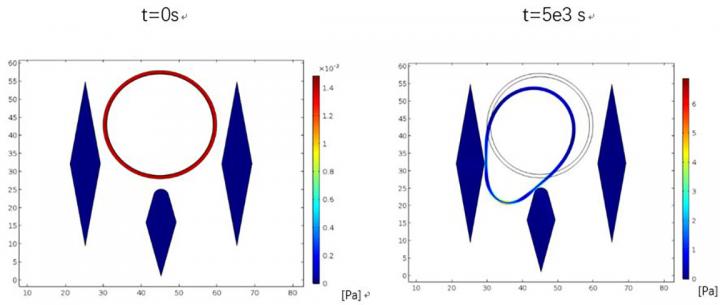A computer model is used to guide the design of tiny pillars in a microfluidic device used to detect malignant multiple myeloma cells

Credit: Lidan You, University of Toronto
WASHINGTON, D.C., November 19, 2019 — Multiple myeloma is a type of blood cancer in which malignant plasma cells, a type of white blood cell, accumulate in the bone marrow. This leads to bone destruction and failure of the marrow, which in healthy individuals, produce all the body’s red blood cells. The most recent data from the American Cancer Society estimates that almost 27,000 new cases of MM are diagnosed every year, and of these, over 11,000 patients died.
Recent studies have shown some myeloma cells can leave the bone marrow and enter the blood stream. The presence of these cells, known as clonal circulating plasma cells, or cCPCs, in the blood has been correlated with shorter survival times.
Until now, it has been difficult to detect cCPCs in the blood. Existing methods cannot always detect the low levels of these cells in MM patients. In this week’s issue of Biomicrofluidics, from AIP Publishing, investigators report the development of a new device that can detect and isolate cCPCs from small samples of blood.
The device is a type of filter that separates malignant plasma cells from normal ones. It is based on a concept known as microfluidics. The filtering action is due to tiny pillars in the flow channel, designed in a precise way that allows normal blood cells through the filter while capturing the cancerous cCPCs.
The scientists who developed this device used a computational model to consider circular-, square- and diamond-shaped pillars of various sizes for their design. Their computer model showed the diamond shape provided a low resistance to flow. They also found by adjusting the diamond shape so that the pillars were longer and more pointed, the filtering action was improved.
Red blood cells are the smallest cells in blood plasma, with diameters in the range of 6-8 microns. White blood cells (WBCs) are bigger, with diameters ranging from 7 to 30 microns. While the cancerous cCPCs are large, with a size of 30-50 microns, the smallest cCPCs are about the same size as the largest WBCs. However, WBCs can deform and squeeze between the tiny pillars. The cCPCs are stiffer and cannot deform this way, so they end up stuck in the filter.
Studies were carried out with cultured cancer cells as well as on blood samples from patients with MM. The amount of cCPCs captured from patients with active MM was much higher than from patients in remission or from healthy individuals. Co-author Lidan You said, “This device shows great potential as a noninvasive method for either early detection or monitoring of MM disease progression.”
###
The article, “Mechanical segregation and capturing of clonal circulating plasma cells in multiple myeloma using micropillar-integrated microfluidic device,” is authored by Dongfang Ouyang, Yonghua Li, Wenqi He, Weicong Lin, Lina Hu, Chen Wang, Liangcheng Xu, Jaewon Park and Lidan You. The article will appear in the journal Biomicrofluidics on Nov. 19, 2019 (DOI: 10.1063/1.5112050). After that date, it can be accessed at https:/
ABOUT THE JOURNAL
Biomicrofluidics rapidly disseminates research in fundamental physicochemical mechanisms associated with microfluidic and nanofluidic phenomena. The journal also publishes research in unique microfluidic and nanofluidic techniques for diagnostic, medical, biological, pharmaceutical, environmental, and chemical applications. See https:/
Media Contact
Larry Frum
[email protected]
301-209-3090
Related Journal Article
http://dx.





